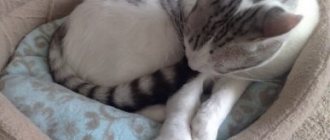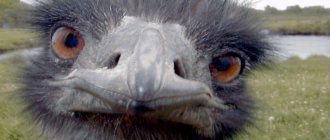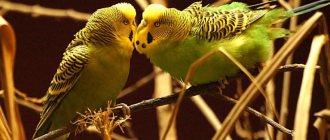- Wild animals
- >>
- Reptiles
The gecko is a small lizard that lives in subtropical and tropical regions. She has amazing limbs. The animal's paws are covered with many hairs, thanks to which the lizard can walk on vertical surfaces, such as walls, window panes and even the ceiling. There are a large variety of geckos. They differ from each other in color, size and body structure.
Origin of the species and description
Photo: Gecko
Strictly speaking, a gecko is not a separate species, but a common name for all representatives of the gecko family or, as they are also called, clasps. In total, the family consists of 57 genera and 1121 species. The most famous of these is the genus Gekko, or True Gecko, which includes 50 species.
Video: Gecko
The name comes from the Malay language, in which these lizards were called "Gek-ko", an onomatopoeic cry of one of the species. Geckos come in different shapes, colors and sizes. Among the species of these lizards, the most famous are:
- Toki the gecko;
- half-toed gecko;
- leaf-tailed;
- spotted leopard gecko;
- comb-toed;
- thin-toed;
- broad-tailed felsuma;
- Madagascar;
- squeaky;
- steppe.
Geckos have a fairly ancient origin, as evidenced by their anatomical structure. Particularly primitive are leopard geckos, which can be considered the most ancient of modern geckos. They are characterized by unpaired parietal bones and anterior concave (procoel) vertebrae.
They also have widened collarbones with holes on the inner sides. Sometimes paleontologists find fossil geckos that are tens of millions of years old. Also, the supposed ancestors of modern geckos and chameleons were found in amber in Southeast Asia. According to preliminary estimates, they are about 99 million years old.
A common distinguishing feature of all geckos is the structure of their limbs. The legs of reptiles end in feet with five evenly spread toes. On the inside they have small ridges consisting of very fine hairs or bristles, approximately 100 nanometers in diameter, and with triangular tips.
It is they that allow the animal to attach to any surface, including a completely smooth one, due to the forces of intermolecular interaction - van der Waals forces. Unsticking occurs due to changes in the angle of individual hairs. The gecko is capable of sticking and unsticking the same finger up to 15 times per second.
Interesting fact: due to the “super stickiness” of its paws, a gecko weighing only 50 g can hold objects up to 2 kg with its paws, that is, 40 times heavier than the gecko itself. To catch a gecko, scientists usually use a water gun, since when wet, the gecko is unable to cling to the surface and escape.
Choosing a pet gecko
23/11/2016, 11:00
The gecko family includes approximately 1,500 different species of lizards. All of them are very interesting animals that can climb even on completely smooth surfaces such as glass, thanks to special pads on their paws. This feature constantly attracts the attention of scientists who have carefully studied the properties of the pads. Each of them is covered with thousands of thin lamellar hairs. It is believed that the unusually strong adhesion of the gecko's paws to the surface is explained by the forces of intermolecular interaction.
Another unusual feature of geckos is that they are the only lizards that can make sounds. Chirping is one of the ways geckos communicate with each other, along with head movements and tail flapping. One of the geckos' means of self-defense is to drop their tail. Then the tail grows back, but usually no longer reaches the length of the “original” and may differ from it in color.
Some gecko species are extremely popular as pets and are extensively bred in captivity. Below we provide a detailed description of the varieties most common among "house geckos".
Spotted Leopard Gecko
The most common type of gecko as a pet. In nature, they live in the deserts of Pakistan and northwestern India. These are hardy reptiles that do not require complex care. They differ from other species by their terrestrial lifestyle and almost complete inability to climb. These are nocturnal lizards that hide under stones or in burrows during the hot season; They are very fond of various shelters in terrariums.
Thanks to selective breeding, today there are a huge number of color morphs of leopard geckos, from albino to bright orange lizards with a single long stripe from head to tail. Spotted leopard geckos have an easygoing disposition and easily get used to being handled by their owners.
Eyelash banana gecko
These wonderful lizards are found exclusively in the forests of New Caledonia. For some time they were even considered extinct, but they were discovered again only in 1994. Now, thanks to selective breeding programs in the United States and Europe, eyelash geckos are one of the most common pet reptiles.
The species name comes from the fact that these geckos have eyelash-like protection over their eyes. This is a nocturnal terrestrial species. Eyelash geckos have small claws at the ends of their toes that help them climb various surfaces. The prehensile tail of geckos, like their paws, ends in a sticky pad.
These are very hardy lizards that are easy to care for. You can pick them up. Banana eaters, as their name suggests, eat fruits and insects. These geckos need a vertical terrarium with lots of branches. Live plants are also highly desirable.
Madagascar day gecko (green felsuma)
These geckos are found only in Madagascar and nearby small islands. They are characterized by bright colors: they are usually green with red markings, a yellow head and two bright blue stripes on the sides.
Unlike many other gecko species, green felsumas are diurnal. They love to bask in the sun, sitting on a branch: this way the geckos receive the ultraviolet radiation they need. Felsums are more sensitive to improper care than the previous two types. But an owner who has collected the necessary information and properly equipped a terrarium for a Madagascar day gecko will be able to enjoy the company of his pet for many years without any problems. This species reproduces easily in captivity.
Green felsumas can be very aggressive towards their relatives, so only opposite-sex pairs can be kept together. Males will fight until one of them dies. The male and female usually get along well, but at first after meeting them you need to carefully monitor them. Felsums are very shy, and they must get used to their owner before they allow themselves to be observed. These lizards have very delicate skin, so they cannot be handled.
To make your pet feel at home, he needs a vertical terrarium with a lot of live plants and hollow bamboo. If you cut holes in the bamboo, you will be able to see lizards poking their heads out to survey their surroundings.
Williams' dwarf gecko
The males of these graceful lizards are distinguished by their bright blue coloration, while the females have a modest brown or dark green coloration. Dwarf geckos were first discovered in the middle of the last century in the forests of Eastern Tanzania. Apparently, this is the only place on Earth where they are found.
Unfortunately, the natural habitat of dwarf geckos is being destroyed due to tree cutting, so their numbers in nature are constantly decreasing. Since March 2012, the export of wild-caught geckos has been completely banned, so currently only captive-bred specimens of this species are available for purchase. And, although after the embargo the prices for geckos have increased significantly, in general this is rather a positive thing, since lizards born in captivity are more hardy and do not require as complex care as their wild-caught counterparts.
The care required for the Williams dwarf gecko is approximately the same as for the green felsuma. These lizards are also diurnal. They need a vertical terrarium with a large number of living plants. Williams' dwarf geckos eat insects and flower nectar. Males cannot be kept together.
Williams' dwarf geckos communicate with each other using a distinctive chirping sound, as well as body language: they puff out their throats, shake their heads and wag their tails. They are brave reptiles that are easy to tame. Because of their delicate skin, they should not be handled, but they can be trained to take food from their owner's hands.
Appearance and features
Photo: Gecko lizard
A common feature of all geckos, apart from their prehensile paws, is that they all have a large head relative to the body, the body itself is flattened but dense, the limbs are short, and the tail is of medium length and thickness. The size of the lizard varies depending on the specific species. For example, the largest Toki species grows up to 36 cm long, and the smallest Virginia large-toed grows to an average of 16–18 mm. An adult weighs only 120 milligrams.
Animal skin is covered with small scales. Among the small scales there are also large fragments scattered chaotically throughout the body. The coloring of reptiles depends greatly on their habitat. Among geckos, there are both representatives of bright green, blue, turquoise, red, orange colors, and camouflaged inconspicuous species that are difficult to distinguish against the background of stones, leaves or sand, especially if the animal does not move. There are both single-colored species and spotted ones, as well as those with varying colors in halftones from one part of the animal’s body to another. Periodically, geckos may molt and eat and eat the fallen pieces of old skin.
Like many other lizards, the gecko has special lines on its tail that allow it to quickly break away if the animal is caught by a predator. The tail may fall off on its own if it is not touched, but the animal has experienced severe stress. After this, a new tail grows over time due to regeneration. An additional feature is that the tail also accumulates reserves of fat and water, which the animal consumes during times of hunger.
Geckos, with the exception of the leopard species, cannot blink. This is due to the fact that their eyelids are fused. But they can clean their eyes with their long tongue. The animals' eyes are greatly enlarged and resemble a cat's in appearance. Pupils dilate in the dark.
Description and area
Geckos are small to medium sized reptiles. The parietal bones are paired, the shape of the clavicles is expanded. With short limbs, they have an enlarged head and a flattened body. The tail is necessary for storing fat and protecting against rapid death without nutrition. During an attack, it may be reset with the further development of a new one, which will not look so nice.
The color depends on the conditions in which the lizard lives. Thin skin has scales with random rows of enlarged elements, which are responsible for color. Some Geckos look bright, there are shades on the body:
- green;
- yellow;
- blue;
- red;
- blue;
- turquoise.
It is generally accepted that in the process of evolution, these reptiles learned to change color, adapting to the environment and defending themselves from attacks, which is similar to leopard geckos (Iranian, Turkmen and others). For example, individuals living in the sand are characterized by a beige skin tone with black stripes (South Asian and comb-toed).
Representatives of certain species are able to camouflage themselves under leaves and move in a measured manner, which complicates the task of recognizing them in natural conditions.
The reptile has large eyes without eyelids with a covering in the form of a fixed shell. Geckos are able to distinguish colors with a high degree of accuracy, which helps them hide from hostile species in time and find prey in seconds. The tongue is wide, there is a notch on the front side. Numerous formations on its surface help securely fix the victim.
Geckos have small hairs on their feet that provide reliable grip on the surface. All individuals have 5 widely spaced toes. Some varieties are additionally equipped with claws. Both in nature and in artificial conditions, reptiles regularly make loud sounds, especially during the mating season.
The best habitat conditions for Geckos are the tropics and subtropics, but they can be found on all continents, with the exception of Antarctica. Reptiles are more comfortable at an air temperature of +25 °C. Many species inhabit:
- southern part of Europe;
- islands of South America;
- African countries;
- southwest USA.
The dimensions of reptiles are determined by age and species. For example, dwarf varieties grow no more than 5 cm, and large varieties reach 35 cm. Reptiles are accustomed to living in colonies with small areas allocated to each. Inactive during the daytime, they go out hunting and searching for individuals for breeding at nightfall.
Most geckos are oviparous, but some species are viviparous. When she wants to mate, the female makes a peculiar sound that attracts a reptile of the opposite sex. After catching it, the male begins the chase, grabs the individual with his jaws and begins fertilization. As a result, the female makes 6-8 clutches of 3-5 eggs per season (average values).
Where does the gecko live?
Photo: Gecko animal
The habitat of these reptiles is extensive. Geckos are distributed throughout the world, although most species live in tropical and subtropical zones. Geckos are cold-blooded, so their habitats are those where the ambient temperature does not fall below +20 °C. The normal habitat for them is considered to be from +20 to + 30 degrees, that is, they are quite thermophilic.
Some species can live in mountains or desert areas in the sand, but most prefer river valleys, tropical forests and lead an arboreal lifestyle. In many of their habitats, geckos also settle in villages and even large cities. Moreover, it often begins with people themselves placing them in their homes to get rid of insects, but then their offspring spread on their own. Geckos have realized that the light of lamps is very attractive to nocturnal insects, and they use this to hunt.
Geckos are quite widespread in Southeast Asia, on the islands of Indonesia, on the African mainland, on the island of Madagascar, in Australia, as well as in both Americas. Some reptiles have spread to other continents thanks to humans, for example, the Turkish half-toed gecko spread across Central America after some individuals arrived there with luggage.
Independent spread across the islands is facilitated by the fact that gecko eggs are quite resistant to salty sea water, and can accidentally end up in areas surrounded by water along with logs.
What does a gecko eat?
Photo: Green gecko
Geckos are predators, so they do not eat plant foods. The main diet of these lizards is insects. Geckos are quite voracious, so whenever possible they try to consume as much food as possible. Their excess fat reserves are deposited in the tail, which is a kind of reservoir. In times of hunger, geckos obtain the necessary energy from reserves in their tail. Geckos readily drink dew as a liquid. Reptiles are unpretentious when it comes to food, so their food is quite varied.
The typical diet of geckos is:
- various midges;
- worms;
- insect larvae;
- cicadas;
- butterfly caterpillars;
- small arthropods;
- cockroaches.
Less commonly, geckos can eat frogs, small mice, bird eggs (and sometimes even chicks), but this is typical only for large reptiles. Some of them can even eat scorpions. Hunting usually happens as follows. The gecko sneaks up on the victim unnoticed, or simply waits in the place where the victim often appears. Then, after waiting, he attacks her with lightning speed, grabs her with his mouth and kills her with a strong blow to the ground or a nearby stone.
Certain species living in South America have adapted to coexist in caves with bats. The reason is that the floor of the cave is covered with bat droppings, which is a good breeding ground for cockroaches. It is these cockroaches that geckos hunt with almost no effort. Small species of flails cannot hunt large insects, so they are forced to feed on insects that are visible to humans only under a microscope.
Features of character and lifestyle
Photo: Spotted gecko
In natural conditions, almost all geckos live in small colonies. Each consists of one male and several females. The territory of an individual male is very small, and it must constantly be protected from the invasion of other males. Fights occur especially often during the mating season, when lizards fight among themselves until death or severe injury. In normal times, the territory also has to be protected from lizards of other species and from spiders.
Geckos are very clean. They go to the toilet in a separate place, located far from the hibernation site. Very often the entire colony goes to the same place.
Most geckos are crepuscular or nocturnal and spend the day in shelters. This is evidenced by the large eyes of animals with vertical pupils. The exception is only a few species, such as the Green Phelsuma, whose second name is the Madagascar day gecko.
The nocturnal lifestyle is mainly due to the fact that in the habitats of these lizards, it is at night that the surrounding temperature becomes comfortable, and during the day they have to hide in crevices, hollows, holes under stones and in other shelters. Geckos have very sharp eyesight and hearing, so even in low light they are excellent hunters. However, many zoologists believe that geckos see only moving insects.
Some species of flails molt periodically. The process looks like this. First, the animal's skin begins to fade. When the entire head of the reptile, up to the tip of the nose, becomes white, then the lizard itself begins to tear off its old skin. By this time, there is already new bright skin underneath. The entire molting process lasts approximately two to three hours.
A distinctive feature of many tree geckos is that they come to the ground only while feeding. Therefore, when kept in captivity, they require special terrariums so that food is always located a level below. To sleep, the gecko needs to find a narrow space, for example, a crevice, so that not only the reptile’s stomach, but also its back is adjacent to the surface of the wall.
Feeding geckos and lizards at home
The main thing is not to overfeed the inhabitants of the terrarium: the larger they are, the less often they need food. If the size of an individual exceeds 20 centimeters, it is enough to give it food 2 times a week. The diet should be varied, it depends on the type of lizard. Herbivores happily eat pieces of vegetables (carrots, cabbage, bell peppers, zucchini and others), fruits (bananas, apples, melons, citrus fruits, pears and others), and greens. For carnivores, the main products are different: insects (crickets, locusts, grasshoppers, fruit flies), fish, snails, earthworms and mealworms, spiders, crickets, small rodents, and sometimes raw meat can be given. Cottage cheese is also useful - it can be placed on stones or branches, since lizards rarely descend to the ground.
During the breeding season, young animals and females are given “bird stone”, as well as vitamins (the most common are Reptolife, ReptoCal from Tetra and Calcium, Vitamins from LM). Liquid vitamins can be easily applied with a brush to the tip of the lizard's muzzle or eye - this way you will follow the dosage. Moving insects are easiest to feed with tweezers; sedentary ones are released into the terrarium.
Social structure and reproduction
Photo: Gecko in nature
Geckos are not completely social animals. For example, caring for offspring is not at all typical for them. But many of the species do not live alone, but in colonies of one male and several females. Males are usually slightly larger. Most species are not tied to the season during reproduction, which is a consequence of the lack of pronounced seasons in their habitats. Geckos living in the northern parts of the tropics and subtropics mate at the end of winter.
Depending on the species, geckos can lay either soft or hard eggs, but there are also ovoviviparous species. Most geckos are oviparous. Females deposit them in protected places, such as tree hollows. The female attaches the eggs to the bumps. Maternal feelings are unknown to female geckos. After she has laid her eggs, she immediately forgets about her offspring. There are literally several species of geckos that come to incubate the clutch in order to warm it up.
If you look into the hollow, in the habitat of geckos, you can see that the entire inner wall is literally strewn with eggs. Moreover, many of them find themselves at different stages of incubation, since several females can lay eggs in the same place at different times. Very often, after the baby hatches, part of the egg shell remains glued to the wall of the hollow. Therefore, the next clutches of the next geckos are layered on top of the old ones. The incubation period usually lasts about three months.
Reproduction
In nature, individuals are ready to mate all year round, except winter. As a result, the female begins to look for hollows in trees where she can lay eggs. Most often, 6-8 clutches are obtained with a frequency of 30 days. Incubation takes from three months to six months - it all depends on environmental conditions.
Before propagation, you need to place large pieces of bark and small trunks with hollows in the terrarium. The number of offspring also depends on how many places for laying the female can find.
In order for offspring to appear, the temperature in the tank must be maintained at +30 °C. If everything is done correctly, incubation will take approximately 4.5 months. At this time, the female’s body needs as many minerals as possible, including calcium. Otherwise, she will start gnawing on the shell.
A couple of months after laying the eggs, the offspring should be transferred to a separate incubator. This is done for its protection - so that adult individuals cannot eat newly hatched ones. Insect larvae and crickets are suitable for feeding small Geckos.
Natural enemies of geckos
Photo: Gecko
Since geckos are quite small in size, they have natural enemies that they can become food for. Among them are other lizards, rats, predatory mammals, and less often birds. Most often, geckos become victims of snakes - snakes, boa constrictors and some others. For the most part, geckos die from nocturnal predators, but sometimes it happens that they are caught by daytime predators in that short period of time when their activity times overlap.
To protect against enemies, protective coloring is used, as well as a body shape that allows them to camouflage or remain invisible. Particularly successful in this is the species of leaf-tailed gecko, indistinguishable from surrounding plants, and many species of leopard geckos with camouflage coloring. As an additional measure, the ability to discard the tail is used, in the place of which a new one then grows.
Sometimes geckos resort to collective defense. There are cases when a snake attacks an individual, and the rest of the geckos from the same colony begin to attack it, and thereby save the life of a relative. On some remote oceanic islands and coral atolls, geckos are often the only terrestrial reptiles, and in fact in these places they have no natural predators.
Population and species status
Photo: Animal gecko
Most species among the clasps have a status of minimal risk, but there are also vulnerable and endangered species among them. These include Russov's Naked Gecko, listed in the Red Book of Dagestan for the reason that its numbers are very small, the Gray Gecko, whose numbers are quite large, and in suitable habitats its numbers reach 10 individuals per 10 square meters, but on Russian territory its representatives have not been discovered since 1935, the European leaf-toed gecko, listed in the International Red Book and several others.
Populations of many species are being impacted by habitat loss, largely due to changes in terrain and less due to the effects of climate change. Human activities have a significant impact on the pollution of the geckos' natural habitat, which also affects their ability to reproduce and spread. Some of the tree species are under threat of extinction due to intensive deforestation.
But there are also species for which human activity, on the contrary, turned out to be useful and contributed to their spread, including on other continents. The same Toki gecko, originally found in Asia, has spread to the United States and the Hawaiian Islands.











